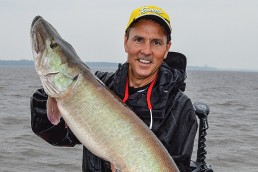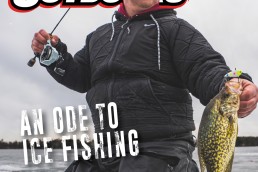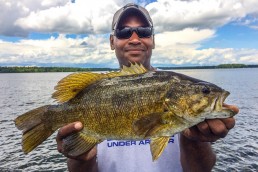Fishing Basin Muskies
When you consider early season muskies, the first reaction is to fish shallow. After all, the two keys to early season success are warm water and baitfish. Naturally, we all associate warm water with shallow water. It typically warms the fastest. However, not every muskie or baitfish in the lake instantly responds to the warmer, shallow water. In fact, there are many species of baitfish—such as cisco—that do not move into shallow, protected bays or channels. Yet, they may still move shallower.
How is this possible? Consider a main-lake basin. Like a bay or channel, the surface waters are warmer. Also, in early season, the water is not too warm to restrict the baitfish from their comfort zone. In addition, you don’t have the summer thermocline established. Together, this early season situation allows baitfish and muskies to suspend shallower in the basin. This makes open-water muskies much more accessible to casting methods. This does not mean there are not muskies in shallow water, it just often means there is an open-water opportunity for early season muskies which in many waters goes overlooked. It doesn’t matter if the water is clear or stained, there are usually some catchable muskies in the basin in early season.
Finding basin muskies
When fishing the basin, the first question is where to start. I use two approaches to find basin muskies. First, I look on a map and locate the largest structural element, whether it’s a flat, point, hump, etc. really doesn’t matter. The largest food shelf is the area I start. The only other exception is, if cruising across the basin, I notice large schools of baitfish. In either situation, that’s where I begin. When you located the largest food shelf in the lake, move out a couple cast lengths and don’t worry about water depths. Sometimes the fish are suspending over the hard to soft bottom transition, other times they are just “out there” away from the structure. Also, they may not be deep.
Generally, whatever the depth of the weed line or top of the hump, that’s the depth and shallower where you’ll find the muskies. So, if the weeds grow to 10 feet, chances are the muskies will be suspended from the surface to 10 feet—even if the depth is 50 feet! Now, make multiple drifts out from the structure covering different areas with each pass. You can systematically cover the portion of the basin adjacent to the large flat. This area of the basin will typically hold muskies that not only suspend and chase open-water forage, but muskies that have pulled off of structure. So, you’ll get the best of both worlds from a perspective of chasing suspended muskies.
The other approach to fishing the basin is locating baitfish. Baitfish can be difficult to locate, but look for large turns or neck-down areas in a basin to stack up bait. Sometimes you’ll find the bait on the calm side of a basin with a giant wind. Of course, other times, they may be on the windy side. When fishing a school of bait, try to work the edges first and then just drift across the school of bait.
Go big or go home
When it comes to lure selection in the open, generally go large and erratic. Magnum and pounder bulldawgs are a great way to fish depths of 10 to 15 feet with ease. These large-profile lures get noticed and create a lot of havoc when ripped through a school of bait. Ripping crankbaits such as Depthraiders is another excellent presentation. The same erratic approach with minnowbaits such as a 9-inch ShallowRaider works well, too. Big bucktails, such as Cowgirls, and even topwaters, such as Topraiders or WalkinRaiders, are excellent options as well. With muskies often being suspended high in the water column at this time, never underestimate the effectiveness of bucktails and topwaters in open water. For a muskie to move from 15 feet down to the surface is nothing more than a couple kicks of their tail. When not sure what lure to use, go with shallower-running lures as the fish are often looking up and you don’t want to fish underneath the muskies.
The basin is an often-overlooked early season opportunity. After the fish spawn, many move to the basin and feed. With the bait being shallow and the thermocline not yet established, the basin is a great place to find some of the biggest muskies at this time. It may seem a little foreign to be fishing over 40 or 50 feet of water in June. But, on many waters across the muskie range, it may be the best option available.
MWO
SHARE THIS POST
You may also like...
Did you enjoy this post?
You can be among the first to get the latest info on where to go, what to use and how to use it!
Jim Saric
Jim Saric is a Legendary Angler in the Freshwater Fishing Hall of Fame, the host and executive producer of The Musky Hunter television series, editor at large of Musky Hunter magazine, a seven-time muskie tournament winner, and a contributing writer for numerous other publications.


